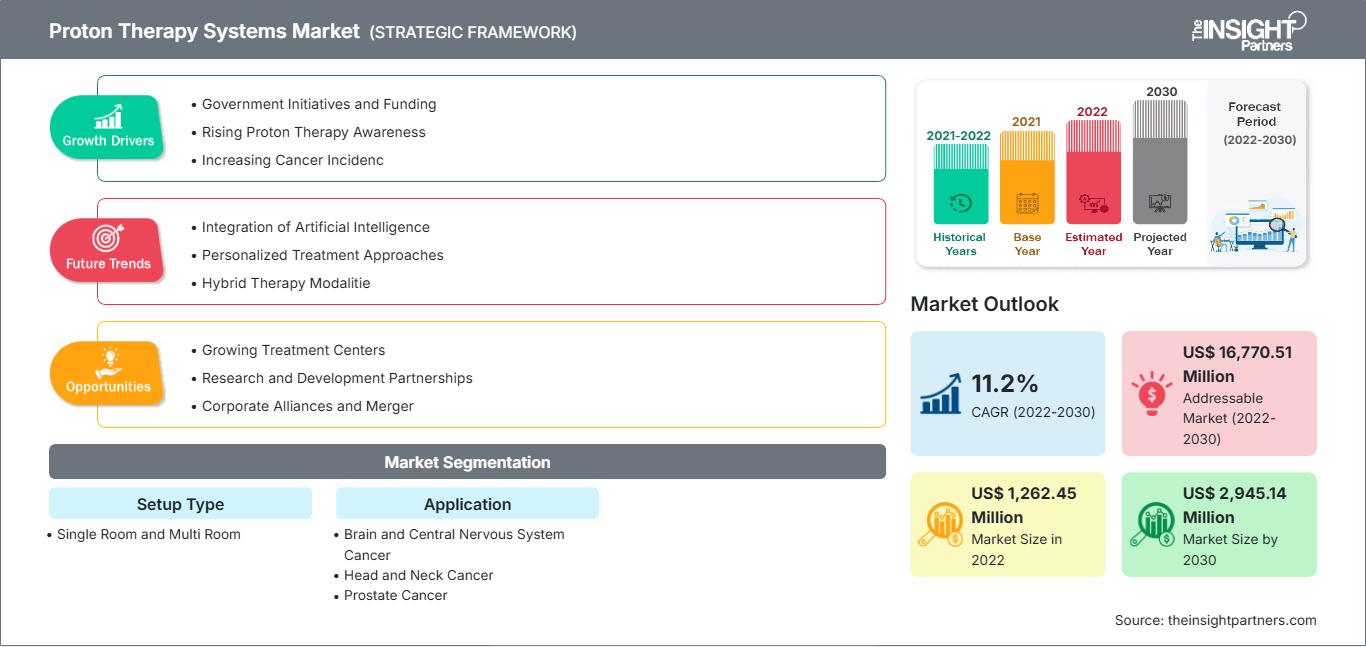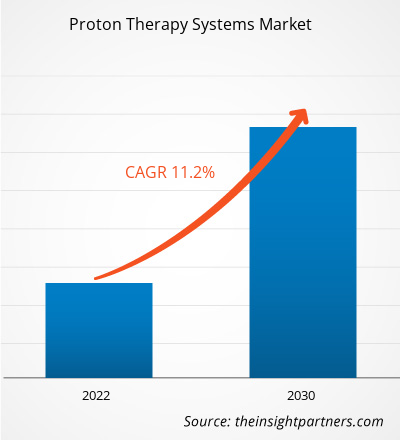[Forschungsbericht] Der Markt für Protonentherapiesysteme soll von 1.262,45 Millionen US-Dollar im Jahr 2022 auf 2.945,14 Millionen US-Dollar im Jahr 2030 wachsen; für den Zeitraum 2022–2030 wird eine durchschnittliche jährliche Wachstumsrate (CAGR) von 11,2 % erwartet.
Markteinblicke und Analystenmeinung:
Die Marktprognose für Protonentherapiesysteme kann Akteuren in diesem Markt dabei helfen, ihre Wachstumsstrategien zu skizzieren.
Ein Protonentherapiesystem ist ein fortschrittliches medizinisches Gerät, das zur hochpräzisen Strahlenbehandlung von Tumoren eingesetzt wird. Diese Systeme sind enorm groß und bestehen aus einem Beschleuniger (Zyklotron), einem Strahltransportsystem, einem Energieauswahlsystem und einer rotierenden Bestrahlungsanlage. Aufgrund ihrer Wirksamkeit bei der Behandlung bestimmter Krebsarten besteht weltweit eine steigende Nachfrage nach Protonentherapie. Faktoren wie die steigende Nachfrage nach fortschrittlichen Behandlungen angesichts der steigenden Krebsinzidenz und die zunehmende staatliche Unterstützung für Protonentherapiezentren treiben das Wachstum des Marktes für Protonentherapiesysteme voran. Die hohen Kosten und die große Fläche der Protonentherapiesysteme hemmen jedoch das Marktwachstum. Darüber hinaus wird erwartet, dass die zunehmende Einführung personalisierter Behandlungsansätze in Kombination mit technologischen Fortschritten in den kommenden Jahren neue Markttrends für Protonentherapiesysteme mit sich bringen wird.
Wachstumstreiber:
Steigende Nachfrage nach fortschrittlichen Behandlungen angesichts der steigenden Krebsinzidenz treibt das Marktwachstum an
Laut der Internationalen Agentur für Krebsforschung (IARC) hatten Lungenkrebs, Brustkrebs und Prostatakrebs im Jahr 2022 die höchste Inzidenzrate. Diese Krankheiten haben eine altersstandardisierte Rate von 23,6, 47,1 bzw. 29,4 Fällen pro 100.000 Einwohner. Schätzungen der IARC zufolge wird die Gesamtzahl der Krebsfälle voraussichtlich von 19,98 Millionen im Jahr 2022 auf 23,71 Millionen im Jahr 2030 und 30,97 Millionen bis 2045 ansteigen. Verschiedene Krebserkrankungen wie Kopf- und Halskrebs (Nasen-, Mund-, Augen- und Kehlkopfkrebs) sowie Hirntumore haben präzise Behandlungsanforderungen, was zu einer hohen Nachfrage nach fortschrittlichen Behandlungsansätzen wie der intensitätsmodulierten Protonentherapie (IMPT) führt. Bei herkömmlichen Strahlentherapien, wie der Röntgenstrahlentherapie, erhält auch das gesunde Gewebe um den Tumor herum eine Strahlendosis, was zu Nebenwirkungen führt und Sekundärkrebs verursachen kann. Die Protonentherapie hingegen unterstützt die wirksame Behandlung komplizierter Tumoren im Gehirn sowie im Kopf- und Halsbereich und minimiert gleichzeitig die Kollateralschäden an umliegendem Gewebe. Somit steigern die hohe Krebsprävalenz und die Nachfrage nach fortschrittlichen Behandlungen die Nachfrage nach protonenbasierter Strahlentherapie und treiben das Marktwachstum für Protonentherapiesysteme voran.
Passen Sie diesen Bericht Ihren Anforderungen an
Sie erhalten kostenlos Anpassungen an jedem Bericht, einschließlich Teilen dieses Berichts oder einer Analyse auf Länderebene, eines Excel-Datenpakets sowie tolle Angebote und Rabatte für Start-ups und Universitäten.
Markt für Protonentherapiesysteme: Strategische Einblicke

- Holen Sie sich die wichtigsten Markttrends aus diesem Bericht.Dieses KOSTENLOSE Beispiel umfasst Datenanalysen, die von Markttrends bis hin zu Schätzungen und Prognosen reichen.
Sie erhalten kostenlos Anpassungen an jedem Bericht, einschließlich Teilen dieses Berichts oder einer Analyse auf Länderebene, eines Excel-Datenpakets sowie tolle Angebote und Rabatte für Start-ups und Universitäten.
Markt für Protonentherapiesysteme: Strategische Einblicke

- Holen Sie sich die wichtigsten Markttrends aus diesem Bericht.Dieses KOSTENLOSE Beispiel umfasst Datenanalysen, die von Markttrends bis hin zu Schätzungen und Prognosen reichen.
Einschränkung:
Hohe Kosten und große Fläche von Protonentherapiesystemen
Ein Protonentherapiesystem ist ein fortschrittliches medizinisches Gerät, das zur hochpräzisen Strahlenbehandlung von Tumoren eingesetzt wird. Es handelt sich um ein riesiges medizinisches Gerät, das aus einem Beschleuniger (Zyklotron), einem Strahltransportsystem, einem Energieauswahlsystem und einer rotierenden Bestrahlungsanlage besteht, was zu großen Oberflächen und hohen Gerätekosten führt. Laut der University of Pennsylvania (Oncolink) wiegen Zyklotrone der Protonentherapiesysteme bis zu 200 Tonnen und haben einen Durchmesser von 6–12 Fuß. Das Portal kann 100 Tonnen wiegen und einen Durchmesser von 40 Fuß haben. Laut einer 2021 in IOPscience veröffentlichten Studie benötigt selbst das kompakte Design (Einzelraumaufbau) eine Fläche von 100 Quadratmetern, während Protonentherapiesysteme mit mehreren Räumen 200–400 Quadratmeter einnehmen. der Fläche.
Außerdem sind Protonentherapiesysteme sehr kapitalintensiv. Ein Einzelraumsystem kann beispielsweise fast 30–50 Millionen US-Dollar kosten. Die Kosten für Protonensysteme mit mehreren Gantrys beginnen bei 300 Millionen US-Dollar und werden normalerweise nur in großen Krankenhäusern und Universitäten installiert. Daher gehören der hohe Kapitalinvestitionsbedarf und die großen Installationsflächen zu den Faktoren, die das Wachstum des Marktes für Protonentherapiesysteme hemmen.
Segmentierung und Umfang des Berichts:
Die Marktanalyse für Protonentherapiesysteme wurde unter Berücksichtigung der folgenden Segmente durchgeführt: Einrichtungstyp und Anwendung.
Nach Einrichtungstyp ist der Markt in Einzelraum und Mehrraum unterteilt. Das Segment Mehrraum-Protonentherapiesysteme hatte 2022 einen größeren Marktanteil. Darüber hinaus wird für das Einzelraum-Segment im Prognosezeitraum eine schnellere CAGR erwartet.
Der Markt wird nach Anwendung in Hirn- und Zentralnervensystemkrebs, Kopf- und Halskrebs, Prostatakrebs, Brustkrebs, Lungenkrebs, Magen-Darm-Krebs und andere unterteilt. Das Segment Hirn- und Zentralnervensystemkrebs hatte 2022 den größten Marktanteil bei Protonentherapiesystemen und wird im Prognosezeitraum voraussichtlich die höchste CAGR verzeichnen.
Regionale Analyse:
Geografisch umfasst der Marktbericht für Protonentherapiesysteme Nordamerika, Europa, den asiatisch-pazifischen Raum, Süd- und Mittelamerika sowie den Nahen Osten und Afrika. Im Jahr 2022 hatte Nordamerika den größten Marktanteil. Die zunehmende Akzeptanz und Einführung neuester medizinischer Geräte, die hohe Krebsprävalenz und Produktinnovationen wichtiger Akteure tragen zur Expansion des Marktes für Protonentherapiesysteme in Nordamerika bei. Nach Schätzungen der American Cancer Society verzeichneten die USA im Jahr 2023 etwa 1,95 Millionen neue Krebsfälle und etwa 0,61 Millionen Todesfälle im Zusammenhang mit der Krankheit. Dies stellt einen deutlichen Anstieg gegenüber den 1,60 Millionen Krebsfällen und 0,60 Millionen Todesfällen im Jahr 2020 dar. Laut der Particle Therapy Co-Operative Group verfügten die USA Ende 2023 mit 46 Protonentherapie-Behandlungseinrichtungen über die weltweit höchste Anzahl an Protonentherapiesystemen.
ProtonentherapiesystemeRegionale Einblicke in den Markt für Protonentherapiesysteme
Die Analysten von The Insight Partners haben die regionalen Trends und Faktoren, die den Markt für Protonentherapiesysteme im Prognosezeitraum beeinflussen, ausführlich erläutert. In diesem Abschnitt werden auch die Marktsegmente und die geografische Lage in Nordamerika, Europa, dem asiatisch-pazifischen Raum, dem Nahen Osten und Afrika sowie Süd- und Mittelamerika erörtert.
Umfang des Marktberichts zu Protonentherapiesystemen
| Berichtsattribut | Einzelheiten |
|---|---|
| Marktgröße in 2022 | US$ 1,262.45 Million |
| Marktgröße nach 2030 | US$ 2,945.14 Million |
| Globale CAGR (2022 - 2030) | 11.2% |
| Historische Daten | 2021-2022 |
| Prognosezeitraum | 2022-2030 |
| Abgedeckte Segmente |
By Setup-Typ
|
| Abgedeckte Regionen und Länder | Nordamerika
|
| Marktführer und wichtige Unternehmensprofile |
|
Dichte der Marktteilnehmer für Protonentherapiesysteme: Auswirkungen auf die Geschäftsdynamik verstehen
Der Markt für Protonentherapiesysteme wächst rasant. Dies wird durch die steigende Endverbrauchernachfrage aufgrund veränderter Verbraucherpräferenzen, technologischer Fortschritte und eines stärkeren Bewusstseins für die Produktvorteile vorangetrieben. Mit der steigenden Nachfrage erweitern Unternehmen ihr Angebot, entwickeln Innovationen, um den Bedürfnissen der Verbraucher gerecht zu werden, und nutzen neue Trends, was das Marktwachstum weiter ankurbelt.

- Holen Sie sich die Markt für Protonentherapiesysteme Übersicht der wichtigsten Akteure
Branchenentwicklungen und Zukunftschancen:
Nachfolgend sind einige strategische Entwicklungen führender Akteure auf dem Markt für Protonentherapiesysteme aufgeführt, die den Pressemitteilungen des Unternehmens zufolge vorliegen:
- Im Januar 2024 brachte OncoRay den Prototyp eines Ganzkörper-MRT-gesteuerten Protonentherapiesystems zur Echtzeitverfolgung beweglicher Tumore mittels Magnetresonanztomographie (MRT) während der Protonentherapie auf den Markt. Die MRT unterstützt die Visualisierung von Tumoren mit erhöhtem Kontrast, was ihr größter Vorteil gegenüber herkömmlichen Bildgebungsverfahren ist. Durch den besseren Kontrast lässt sich der Tumor besser vom umgebenden gesunden Gewebe abgrenzen und das zu bestrahlende Volumen genauer bestimmen.
- Im Dezember 2023 eröffnete die HKSH Medical Group ein neues Protonentherapiezentrum im HKSH Eastern Medical Centre in A Kung Ngam, Shau Kei Wan, Hongkong. Das neue Zentrum verfügt über ein fortschrittliches Protonentherapiesystem und zwei hochmoderne Behandlungsräume. Das System umfasst zwei halbrotierende Protonentherapie-Gantries, das neueste Strahltransportsystem und einen Synchrotron-Beschleuniger.
Wettbewerbslandschaft und wichtige Unternehmen:
Varian Medical Systems Inc, Sumitomo Heavy Industries Ltd, Hitachi Ltd, Ion Beam Applications SA, Mevion Medical Systems, Provision Healthcare LLC, ProTom International, Optivus Proton Therapy Inc, Advanced Oncotherapy plc und B dot Medical Inc gehören zu den führenden Unternehmen, die im Marktbericht für Protonentherapiesysteme vorgestellt werden. Diese Unternehmen konzentrieren sich auf die Entwicklung neuer Technologien, die Verbesserung bestehender Produkte und die Ausweitung ihrer geografischen Präsenz, um der weltweit wachsenden Verbrauchernachfrage gerecht zu werden.
- Historische Analyse (2 Jahre), Basisjahr, Prognose (7 Jahre) mit CAGR
- PEST- und SWOT-Analyse
- Marktgröße Wert/Volumen – Global, Regional, Land
- Branchen- und Wettbewerbslandschaft
- Excel-Datensatz
Aktuelle Berichte
Erfahrungsberichte
Grund zum Kauf
- Fundierte Entscheidungsfindung
- Marktdynamik verstehen
- Wettbewerbsanalyse
- Kundeneinblicke
- Marktprognosen
- Risikominimierung
- Strategische Planung
- Investitionsbegründung
- Identifizierung neuer Märkte
- Verbesserung von Marketingstrategien
- Steigerung der Betriebseffizienz
- Anpassung an regulatorische Trends






















 Kostenlose Probe anfordern für - Markt für Protonentherapiesysteme
Kostenlose Probe anfordern für - Markt für Protonentherapiesysteme